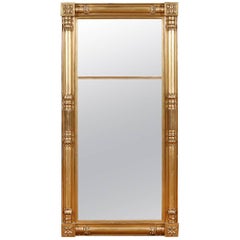Isaac Platt On Sale
Recent Sales
Antique Early 19th Century American Neoclassical Wall Mirrors
Gold Leaf
A Close Look at neoclassical Furniture
Neoclassical design emerged in Europe in the 1750s, as the Age of Enlightenment reached full flower. Neoclassical furniture took its cues from the styles of ancient Rome and Athens: symmetrical, ordered, dignified forms with such details as tapered and fluted chair and table legs, backrest finials and scrolled arms.
Over a period of some 20 years, first in France and later in Britain, neoclassical design — also known as Louis XVI, or Louis Seize — would supersede the lithe and curvaceous Rococo or Louis XV style.
The first half of the 18th century had seen a rebirth of interest in classical antiquity. The "Grand Tour" of Europe, codified as a part of the proper education of a patrician gentleman, included an extended visit to Rome. Some ventured further, to sketch the ruins of ancient Greece. These drawings and others — particularly those derived from the surprising and rich archaeological discoveries in the 1730s and ’40s at the sites of the Roman cities of Pompeii and Herculaneum — caused great excitement among intellectuals and aesthetes alike.
Neoclassical furniture is meant to reflect both grace and power. The overall appearance of neoclassical chairs, tables and cabinetry is strong and rectilinear. These pieces are, in effect, classical architecture in miniature: chair and table legs are shaped like columns; cabinets are constructed with elements that mirror friezes and pediments.
Yet neoclassicism is enlivened by gilt and silver leaf, marquetry, and carved and applied ornamental motifs based on Greek and Roman sculpture: acanthus leaves, garlands, laurel wreaths, sheaves of arrow, medallions and chair splats are carved in the shapes of lyres and urns. Ormolu — or elaborate bronze gilding — was essential to French design in the 18th and 19th centuries as a cornerstone of the neoclassical and Empire styles.
As you can see from the furniture on these pages, there is a bit of whimsy in such stately pieces — a touch of lightness that will always keep neoclassicism fresh.
Find antique neoclassical furniture today on 1stDibs.
Finding the Right pier-mirrors-console-mirrors for You
Mirrors are versatile, flattering and unobtrusively elegant in any space. Pier mirrors, or console mirrors, are similar to trumeau mirrors as they are traditionally installed between windows. These mirrors are usually very tall and placed on piers that support the ceiling. Sometimes they are suspended from the pier or affixed to the wall.
Pier mirrors were extremely popular in the 18th and 19th centuries, and they were typically used to decorate receiving rooms. They often had extravagant, golden frames that matched the fashionable Rococo and neoclassical styles. Console tables would generally be placed beneath pier mirrors, thus pier mirrors are sometimes referred to as console mirrors.
Mirrors of any kind can be used to visually enlarge and illuminate any room in your home, and just as vanity tables and wall hangings are enjoying a revival of interest, mirrors of all styles are being reinvigorated for the digital era. Pier mirrors are beautiful statement pieces that complement a range of furniture styles and many different aesthetics. Gilded frames are popular choices for pier mirrors, but more modern, streamlined styles are also available.
Find a variety of antique and vintage pier mirrors and console mirrors on 1stDibs.
